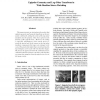Free Online Productivity Tools
i2Speak
i2Symbol
i2OCR
iTex2Img
iWeb2Print
iWeb2Shot
i2Type
iPdf2Split
iPdf2Merge
i2Bopomofo
i2Arabic
i2Style
i2Image
i2PDF
iLatex2Rtf
Sci2ools
ICPR
2008
IEEE
2008
IEEE
Epipolar geometry and log-polar transform in wide baseline stereo matching
This paper presents an interesting observation that epipolar geometry and log–polar transform can be naturally combined by setting the center of the log–polar transform into the epipoles. This choice preserves the linearity of the epipolar lines. Moreover, the setting is especially advantageous, when camera moves towards the optical axis of the camera as the log–polar transform compensates the large scale changes in the scene. This practically implies that conventional matching techniques can be used with wide baseline images. We discuss the approach with both calibrated and uncalibrated cameras and show some dense wide baseline reconstruction examples where the epipoles are close to the image centers.
| Added | 30 May 2010 |
| Updated | 30 May 2010 |
| Type | Conference |
| Year | 2008 |
| Where | ICPR |
| Authors | Kimmo Palander, Sami S. Brandt |
Comments (0)

